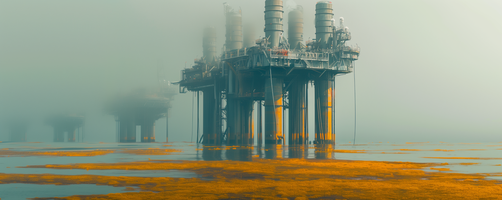Energy production in Hergom: Difference between revisions
(→Biogas) |
(→Biogas) |
||
| Line 1: | Line 1: | ||
== Biogas == | == Biogas == | ||
[[File:Biomaskelp.png|thumb|502x502px|Kelp biomass field rig, rigs like these tend enormous kelp fields that choke millions of hectares along the coast of Hergom, producing and harvesting biomass at the expense of the coastal ecology they destroy.]] | [[File:Biomaskelp.png|thumb|502x502px|Kelp biomass field rig, rigs like these tend enormous kelp fields that choke millions of hectares along the coast of Hergom, producing and harvesting biomass at the expense of the coastal ecology they destroy.]]Biogas has become the primary source of storable energy in Hergom, a reality that has led the Wolgos to dedicate large portions of their coasts to the cultivation of giant kelp. These expansive fields, spanning millions of hectares, are maintained by agricultural and processing rigs designed to ensure optimal growth conditions. The rigs also delineate the boundaries of the fields and support wave breakers that calm the surrounding waters, facilitating continuous and uninterrupted growth throughout the year. | ||
The scale and intensity of these kelp fields are such that they drastically alter the coastal ecosystems. The dense growth of giant kelp chokes the light and nutrient flow to the waters beneath, resulting in near-barren shallow coasts. These areas are now populated primarily by giant kelp, parasitic krill, and jellyfish, with a significant decline in the diversity of underwater flora and fauna. | |||
Harvesting this kelp is a continuous process, achieved through the use of extensive chain conveyors that transport the kelp from the fields to enormous biodigester tanks located in coastal refineries. These refineries convert the kelp into methane and other gaseous hydrocarbons, which are then exported across Hergom via an extensive network of pipelines. This biogas is distributed to various industries and fuel stations, serving as a vital energy source for vehicles and industrial processes. | |||
However, the biogas production process generates significant waste, primarily nutrient-rich effluent from the biodigesters. This waste is often discharged back into the coastal waters, where it can lead to severe ecological consequences. The influx of nutrients from the refineries promotes the growth of algae, resulting in massive algae blooms. These blooms, while initially beneficial for some marine organisms, can lead to toxic shocks in the coastal biosphere. | |||
Algae blooms consume large amounts of oxygen from the water during their decay process, creating hypoxic conditions that can suffocate marine life. Furthermore, certain types of algae produce toxins that are harmful to both marine organisms and humans. These toxins can accumulate in the food chain, affecting a wide range of species and potentially causing health issues for the human population that relies on seafood. | |||
Despite these severe environmental impacts, the Wolgos continue to expand their biogas operations without regard for the ecological damage. The unchecked growth of kelp fields and the increasing discharge of waste into the coastal waters highlight the Wolgos' prioritization of industrial advancement over environmental preservation. The consequences of these actions are seen in the declining health of marine ecosystems and the increasing frequency of toxic algae blooms, which threaten both marine life and human communities reliant on the sea. | |||
== Nuclear == | == Nuclear == | ||
Revision as of 02:23, 16 June 2024
Biogas

Biogas has become the primary source of storable energy in Hergom, a reality that has led the Wolgos to dedicate large portions of their coasts to the cultivation of giant kelp. These expansive fields, spanning millions of hectares, are maintained by agricultural and processing rigs designed to ensure optimal growth conditions. The rigs also delineate the boundaries of the fields and support wave breakers that calm the surrounding waters, facilitating continuous and uninterrupted growth throughout the year.
The scale and intensity of these kelp fields are such that they drastically alter the coastal ecosystems. The dense growth of giant kelp chokes the light and nutrient flow to the waters beneath, resulting in near-barren shallow coasts. These areas are now populated primarily by giant kelp, parasitic krill, and jellyfish, with a significant decline in the diversity of underwater flora and fauna.
Harvesting this kelp is a continuous process, achieved through the use of extensive chain conveyors that transport the kelp from the fields to enormous biodigester tanks located in coastal refineries. These refineries convert the kelp into methane and other gaseous hydrocarbons, which are then exported across Hergom via an extensive network of pipelines. This biogas is distributed to various industries and fuel stations, serving as a vital energy source for vehicles and industrial processes.
However, the biogas production process generates significant waste, primarily nutrient-rich effluent from the biodigesters. This waste is often discharged back into the coastal waters, where it can lead to severe ecological consequences. The influx of nutrients from the refineries promotes the growth of algae, resulting in massive algae blooms. These blooms, while initially beneficial for some marine organisms, can lead to toxic shocks in the coastal biosphere.
Algae blooms consume large amounts of oxygen from the water during their decay process, creating hypoxic conditions that can suffocate marine life. Furthermore, certain types of algae produce toxins that are harmful to both marine organisms and humans. These toxins can accumulate in the food chain, affecting a wide range of species and potentially causing health issues for the human population that relies on seafood.
Despite these severe environmental impacts, the Wolgos continue to expand their biogas operations without regard for the ecological damage. The unchecked growth of kelp fields and the increasing discharge of waste into the coastal waters highlight the Wolgos' prioritization of industrial advancement over environmental preservation. The consequences of these actions are seen in the declining health of marine ecosystems and the increasing frequency of toxic algae blooms, which threaten both marine life and human communities reliant on the sea.